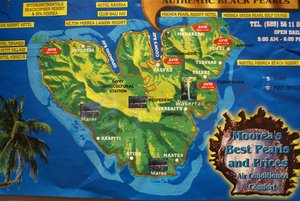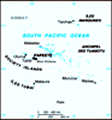Advertisement
Published: January 30th 2010

 Moorea Map
Moorea Map
A colorful map showing the island layout.Welcome to Moorea! The early Polynesians named this island “Tahiti-iti”, meaning the little fish of Tahiti. It has also been known as Aimeo, and Fe’e. It is only in recent times that the island has been known as Moorea. It is a rugged, triangular-shaped mountainous island, measuring approximately 10 miles on each side. The lush tropical vegetation, white sandy beaches and small villages spread along the coast make the 37 mile drive along the island’s coast road most pleasurable.
The coral reef surrounding the island is approximately half to three quarters of a mile off shore and offers a number of openings to pass through. The beautiful, clear waters of the Lagoon provide excellent snorkeling, diving and other water sports.
Geographically, the island is an ancient volcano. Cook’s Bay, where the ship anchors, and Opunohu Bay on the north coast are old craters taken by the sea.
Both bays have been used by many filmmakers as a backdrop for their productions. Over millions of years the island has eroded into castellated peaks and crags. Perhaps the most famous peak to be seen on the island is James Mitchener’s “Bali Hai”. Its real name is Mouaroa. This year we

 Moorea and Bali Hai
Moorea and Bali Hai
This shows the island and Bali Hai as we approach early in the morning.didn’t take the island tour that takes us up to the Belvedere, a high point on the island that offers spectacular views of the bays, peaks and closer look of Bali Hai. We have included a photo of us taken last year with Bali Hai in the background.
This year we decided to take the Dolphin & Whale Watching Expeditions tour. We heard many positive reviews of it from folks who had taken it in the past. It is with Dr. M. Michael Poole, Ph.D, who has conducted research on whales and dolphins since 1980. His knowledge of dolphins and whales was unbelievable! His life’s goal when he was a child was to study dolphins and whales in Tahiti, which he made come true. He received a Bachelor’s Degree from the University of Miami. His three years of Master’s Degree research (California State University, Sonoma) discovered the route and timing used by gray whale females and calves migrating northward along the California coast. His Ph.D from the University of California, Santa Cruz was based on six years of spinner dolphin research at Tahiti and Moorea, where he was based at the University California Berkeley research station and was funded

 Moorea Terrain
Moorea Terrain
The coast and rugged terrain of the hillside.by Scripps Institution of Oceanography (Un. of Cal., San Diego). He shared a very interesting story with us that when he first heard, in the 80’s, that the Gump family estate had property on Moorea that they wanted to donate, it was first offered to Stanford, who turned it down. On behalf of the University of California, he came to Moorea to look at the property and immediately said…Of course!
Since 1987, Michael’s major scientific efforts have been on Polynesia’s spinner dolphins, humpback whales, rough-toothed dolphins, bottlenose dolphins, pilot whales and other species at eight islands. He discovered that some humpback whales use French Polynesia as a breeding ground, which was previously unknown. Due to 20th century whaling, humpback whales were reduced by 97% worldwide. In 1988 Dr, Poole established French Polynesia’s first dolphin/whale sighting and stranding network; it has received sighting reports on over 20 species of dolphins and whales at or near 30 different islands.
His efforts to help rescue “Humphrey” the humpback whale stranded in the Sacramento River were featured on ‘Nightline’ and ‘Good Morning America’. In 1992 Michael created French Polynesia’s first ever whale watching tours, now called Dolphin & Whale Watching Expeditions, a

 Doug & Annette at Bali Hai
Doug & Annette at Bali Hai
This was taken last year during our island tour with Bali Hai in the background.boat-based eco-tour that takes people to observe and learn about wild, free-ranging dolphins and whales. He uses no means to attract or chum the dolphins but because he knows their habits intimately, and 90-95% of the time his tours find the dolphins. He doesn’t tag them of use any technology to monitor their activities.
The spinner dolphins are the world’s most acrobatic dolphins, and the only ones to spin vertically or horizontally in the air like ballerinas. They are unfortunately killed between Hawaii, Mexico and Peru in the yellow-fin tuna nets. Tuna swim underneath dolphins in those waters, so fishermen purposefully catch dolphins to catch the tuna. Over the past 40-years, 6-8 million dolphins have died in these nets, reducing some populations by over 85%. Their other primary predator is the shark. The spinner dolphin grows to about 5 feet long, about ½ the size of a bottlenose dolphin like ‘Flipper’.
Upon boarding his boat, we traveled slowly out into the bay toward the opening in the reef. He immediately starts our tour giving us information in a very easily understood manner. Because he truly loves what he does, it is easy for him to get excited about

 Our Dolphin Watching Boat
Our Dolphin Watching Boat
Michael Poole's boat with him in the bow.making the tour very interesting and informative for all of us. The dolphins will stay within about 200 feet of the reef, primarily for safety, and only go further out to feed. They feed at about 300 meters. Once outside the reef the sightings began…fortunately we would not be in the 5-10% that wouldn’t see any. And, they definitely came to entertain and play for us! We were there about 2 hours watching and taking photos of them as you’ll see in just a few of the photos Doug & Annette took. Enjoy.
PLEASE INCLUDE YOUR NAME WHEN LEAVING COMMENTS…THANKS!
Advertisement
Tot: 0.137s; Tpl: 0.019s; cc: 14; qc: 65; dbt: 0.0891s; 1; m:domysql w:travelblog (10.17.0.13); sld: 1;
; mem: 1.2mb























Max
non-member comment
Wrong information
1) PHOTO "Moorea and Bali Hai - This shows the island and Bali Hai as we approach early in the morning." Not Mouaroa, that's montain is Mouaputa (meaning mountain with hole). "Doug & Annette at Bali Hai" Photo it's right 2) Cook not arrived in Cook's Bay but in Opunohu Bay. 3) The ancient name of the island is "Aimeho i te rara varu" meaning tentacular octopus.